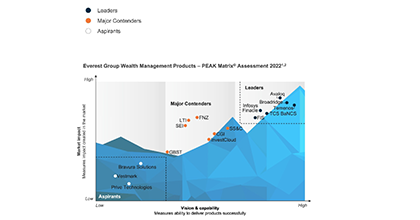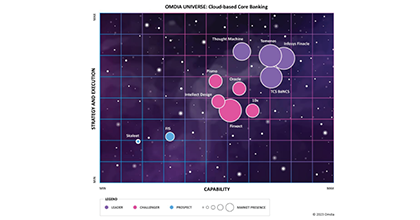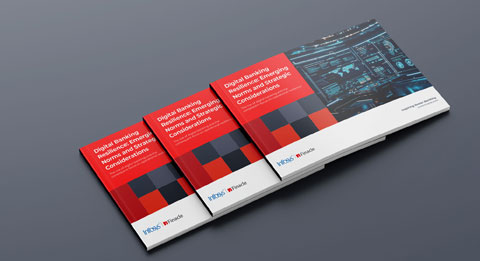-
![]() ESG in bankingESG-conscious banking should create new and future-proof value streams to build a sustainable and resilient business.Read More
ESG in bankingESG-conscious banking should create new and future-proof value streams to build a sustainable and resilient business.Read More -
![Everest Group PEAK Matri Everest Group PEAK Matri]() Everest Group PEAK MatrixA comprehensive solution delivering a full spectrum of wealth products as great experiences. It also improves the productivity of financial advisors and streamlRead More
Everest Group PEAK MatrixA comprehensive solution delivering a full spectrum of wealth products as great experiences. It also improves the productivity of financial advisors and streamlRead More -
![]() Subsidiary of an American Bank in IndonesiaFind out how a leading American bank adapts to a digitalized trade and supply chain finance operations as a part of its larger transformation by leveraging Finacle Trade Finance Solution Suite.Read More
Subsidiary of an American Bank in IndonesiaFind out how a leading American bank adapts to a digitalized trade and supply chain finance operations as a part of its larger transformation by leveraging Finacle Trade Finance Solution Suite.Read More
-
![]() Recomposing Banking: Leading the Digital ContinuumReport gives you a glimpse of the major areas where recomposing banking will create significant impact and value, Infosys Finacle has put together a report on..Read More
Recomposing Banking: Leading the Digital ContinuumReport gives you a glimpse of the major areas where recomposing banking will create significant impact and value, Infosys Finacle has put together a report on..Read More -
![]() Core Banking on Cloud: Navigating to the Fast LaneTake a deep dive into cloud-based core banking and explore the imperatives, opportunities and challenges, and the hallmarks of a robust solution.Read More
Core Banking on Cloud: Navigating to the Fast LaneTake a deep dive into cloud-based core banking and explore the imperatives, opportunities and challenges, and the hallmarks of a robust solution.Read More -
![]() Embracing Payments ComposabilityA step-by-step guide for maximizing Real Time Payment opportunities by embracing Payments Composability...Read More
Embracing Payments ComposabilityA step-by-step guide for maximizing Real Time Payment opportunities by embracing Payments Composability...Read More
-
![]() Shaping Banking’s Next: Banking Technology Trends for 2025 and BeyondThe banking industry has been balancing disruption and opportunity for several years now, and the pace of change shows no signs of slowing as we move into 2025 and beyond.Read More
Shaping Banking’s Next: Banking Technology Trends for 2025 and BeyondThe banking industry has been balancing disruption and opportunity for several years now, and the pace of change shows no signs of slowing as we move into 2025 and beyond.Read More -
![]() Virtual Accounts 2.0: Surpass Conventional Cash Management and Unlock Next-Gen PossibilitiesVirtual Account Management was a groundbreaking shift in the banking landscape, revolutionising use cases like cash concentration, pooling, centralised treasury management, and in-house banking (POBO, ROBO, COBO)Read More
Virtual Accounts 2.0: Surpass Conventional Cash Management and Unlock Next-Gen PossibilitiesVirtual Account Management was a groundbreaking shift in the banking landscape, revolutionising use cases like cash concentration, pooling, centralised treasury management, and in-house banking (POBO, ROBO, COBO)Read More -
![]() Unlocking Hybrid CloudAs banks push forward with their digital transformation agenda, cloud serves as a pivotal enabler. Each bank, at varying stages of adoption, crafts its unique path, dictated by context, regulations, and risk appetite.Read More
Unlocking Hybrid CloudAs banks push forward with their digital transformation agenda, cloud serves as a pivotal enabler. Each bank, at varying stages of adoption, crafts its unique path, dictated by context, regulations, and risk appetite.Read More
-
![]() Banking on CloudThis report from Infosys Finacle delves into the need for accelerating cloud adoption, highlights the current state of the industry, and puts forth key recommenRead More
Banking on CloudThis report from Infosys Finacle delves into the need for accelerating cloud adoption, highlights the current state of the industry, and puts forth key recommenRead More -
![]() Omdia Universe | Cloud-based Core BankingIn the report, Omdia highlights the following key capabilities of leading cloud-based core banking providers:Read more
Omdia Universe | Cloud-based Core BankingIn the report, Omdia highlights the following key capabilities of leading cloud-based core banking providers:Read more
-
![]() Emirates NBDEmirates NBD consolidates its operations on a single version for scalability, agility, and standardization.Read More
Emirates NBDEmirates NBD consolidates its operations on a single version for scalability, agility, and standardization.Read More -
![]() A Global Top 5 BankDiscover how a global top 5 bank headquartered in the US accelerated payments transformation.Read More
A Global Top 5 BankDiscover how a global top 5 bank headquartered in the US accelerated payments transformation.Read More -
![]() Union Bank of IndiaUnion Bank of India launches Union Virtual Connect (UVConn) by leveraging WhatsApp to provide customers personalized banking services.Read More
Union Bank of IndiaUnion Bank of India launches Union Virtual Connect (UVConn) by leveraging WhatsApp to provide customers personalized banking services.Read More

Designing Sustainable Technology Infrastructures for Banking
Blogs
According to an IBM IBV study, almost half (48 percent) of CEOs surveyed across industries say increasing sustainability is one of the highest priorities for their organization in the next two to three years. However, more than half (51%) also cite sustainability as among their greatest challenges in the next two to three years, with lack of data insights, unclear ROI, and technology barriers, as hurdles.
The increasing focus on sustainability has led leading banks to pioneer initiatives such as green finance, green IT, paperless services, and supporting green industries, among others. The journey, however, is incomplete without a focus on energy conservation. Banking leaders can move closer to sustainability goals by measuring and improving the performance of the IT infrastructure and services running the bank.
Energy Consumption, Computing Efficiency and Utilization – The Sustainability Impact
Most data center facilities consume up to 10 to 50 times the energy per floor space of a typical commercial office building1, so for many businesses an energy efficient IT solution is an essential step towards achieving carbon footprint reduction. An energy efficient data center design seeks to address all aspects of carbon footprint savings, from its IT hardware, heating, ventilation and air conditioning equipment to its physical layout and construction. Best practices for reducing electricity consumption include:
- Selecting server hardware that requires a smaller number of physical systems
- Using high energy-efficiency systems
- Keeping systems updated to the latest generation since lower energy consumption per unit of work is generally achieved with technology advancements
- Using system architectures that enable high compute and resource utilization on each system and high compute and storage density to avoid server sprawl
- Using software that enables high utilization of system resources and that enables use of virtualization to utilize targeted resources only when necessary
- Implementing computing models that facilitate resource sharing (cloud computing) and that reduce data and compute movement (edge computing)
- Adopting data center floor plans that decrease the amount of energy used for cooling (hot and cold flow separation and reuse of energy)
Infosys Finacle on IBM Linuxone Is Designed to Help Banks Meet Sustainability Goals
Finacle and IBM LinuxONE deliver a core banking solution on a highly reliable platform series offering benefits of reliability, performance, cloud readiness, scalability and high processing power to banking clients.
Finacle Core Banking Solution containerized version with Red Hat OpenShift on IBM LinuxONE systems can scale elastically while minimizing disruptions to running applications. This helps support peak customer demands. Scalability of LinuxONE is ideal for “systems of record” workloads, such as databases and transaction processing, and can reduce the costs of scaling workloads as well. Clients can deploy banking workloads on IBM LinuxONE Emperor 4 and start with minimum 1 core and scale up to a maximum of 200 cores.
Banks also look to reduce or offset their carbon footprint along with overcoming inadequate operational efficiency caused by server performance, server sprawls and inadequately equipped systems. IT efficiency improves with consolidation of data and applications onto a centralized infrastructure. Running workloads on IBM LinuxONE can reduce server sprawl through consolidation leading to smaller physical server footprint and reduced data center costs. This further leads to more environmentally sustainable IT environment and reduced carbon footprint.
The IBM LinuxONE Emperor 4 is designed for “7 9’s application availability, seamless on-demand scalability and to execute disaster recovery actions to respond to unplanned events. This can enable banks to efficiently deploy and deliver Finacle Core Banking solution to enhance trust.
Extended Capabilities With IBM Linuxone Emperor 4
The new IBM LinuxONE Emperor 4, available globally beginning September 14, 2022, is an enterprise server designed for data serving, core banking and digital assets workloads while helping to reduce energy consumption.
For example, consolidating Linux workloads on five IBM LinuxONE Emperor 4 systems instead of running them on compared x86 servers under similar conditions can reduce energy consumption by 75%, space by 50 percent, and the CO2e footprint by over 850 metric tons annually.2 Integrations with energy monitoring tools on the server also enable clients to track energy consumption.
As a part of the IBM Ecosystem, Infosys Finacle is helping companies unlock the value of cloud investments by implementing the tools and technologies that can help them succeed in a hybrid multicloud world. Based on Linux, customers can benefit from open standards and an ecosystem that LinuxONE offers including modern DevOps and a variety of popular software. This can also help to remove operational barriers when customers deploy and manage technologies on cloud-native infrastructure.
You Can Find Additional Resources About Finacle on IBM Linuxone Below:
- Learn more aboutInfosys Finacle on IBM LinuxONE
- Learn more about LinuxONE
References
1. U.S. Department of Energy, https://www.energy.gov/eere/buildings/data-centers-and-servers (excerpt from: https://www.ibm.com/downloads/cas/GYR3MWQN)
2. Disclaimer: Compared 5 IBM z16 Max 125 model consists of three CPC drawers containing 125 configurable cores (CPs, zIIPs, or IFLs) and two I/O drawers to support both network and external storage versus 192 x86 systems with a total of 10364 cores. IBM z16 power consumption was based on inputs to the IBM z16 IBM Power Estimation Tool for a memo configuration. x86 power consumption was based on March 2022 IDC QPI power values for 7 Cascade Lake and 5 Ice Lake server models, with 32 to 112 cores per server. All compared x86 servers were 2 or 4 socket servers. IBM Z and x86 are running 24x7x365 with production and non-production workloads. Savings assumes a Power Usage Effectiveness (PUE) ratio of 1.57 to calculate additional power for data center cooling. PUE is based on Uptime Institute 2021 Global Data Center Survey https://uptimeinstitute.com/about-ui/press-releases/uptime-institute-11th-annual-global-data-center-survey

©2025 -Edgeverve Systems Limited | All rights reserved
















